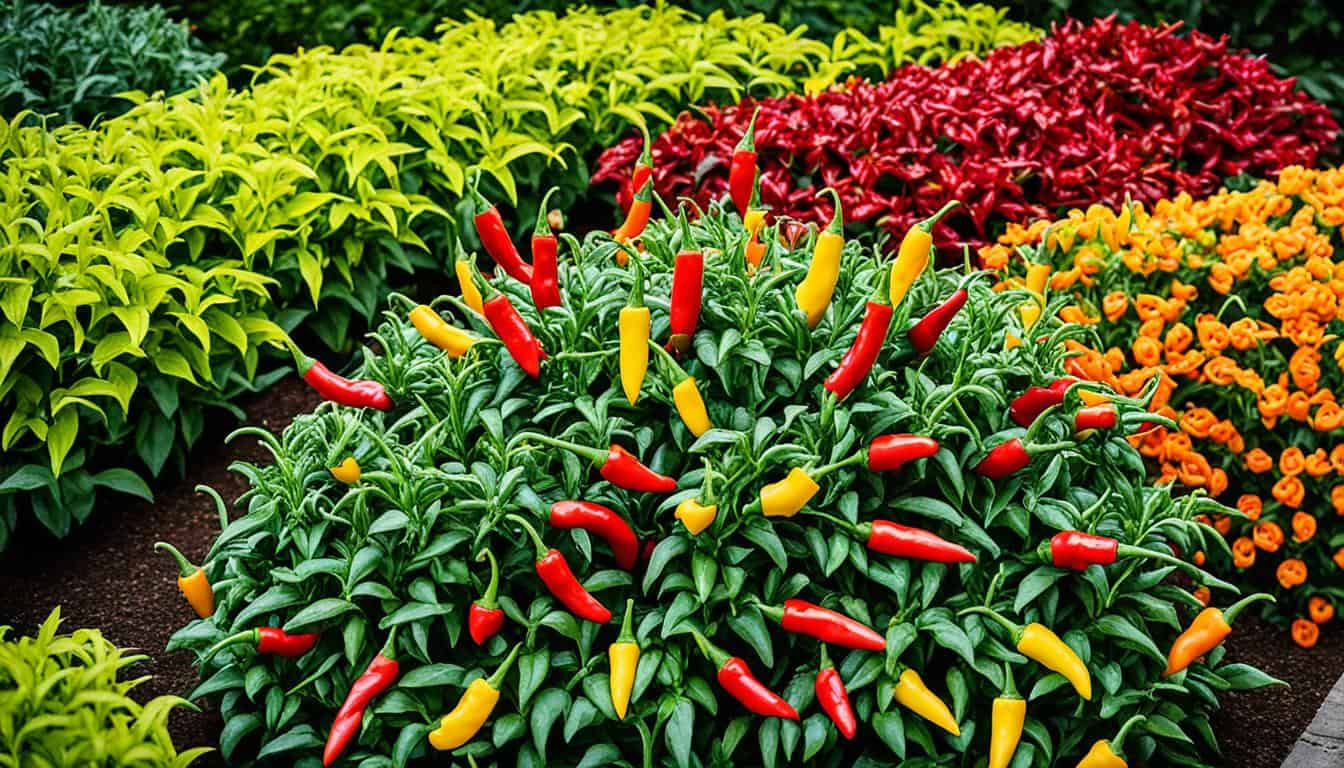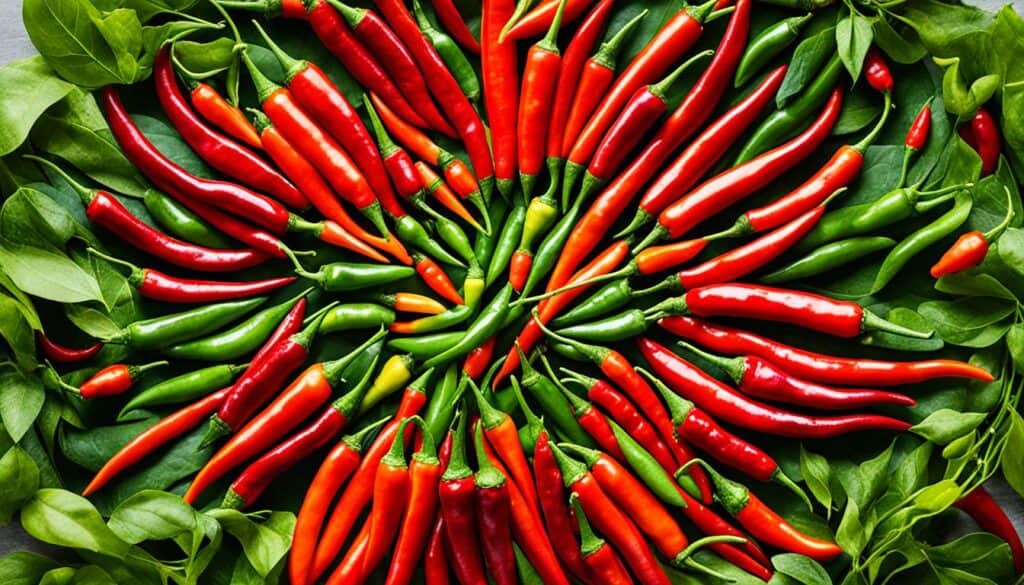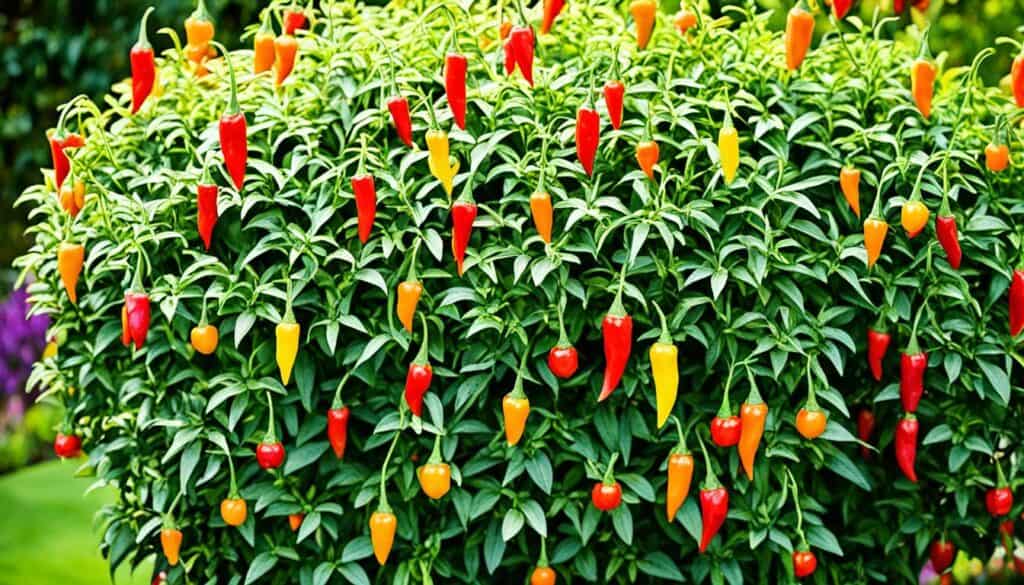Welcome to the world of ornamental peppers, where beauty meets spice! Did you know that ornamental peppers are not only stunning to look at but also edible? These vibrant peppers come in a wide range of colors and shapes, adding a burst of color to your garden like no other plant can. Whether you’re looking to create a picturesque landscape or spice up your culinary creations, ornamental peppers are the perfect choice. Let’s explore the world of these colorful and versatile plants!
Key Takeaways:
- Ornamental peppers are both visually stunning and edible, making them a unique addition to any garden.
- These peppers come in a wide range of vibrant colors and shapes, offering endless possibilities for landscaping.
- Growing ornamental peppers is relatively easy, making them suitable for both beginner and experienced gardeners.
- Ornamental peppers can be used to create focal points, add pops of color to flower beds, and even enhance decorative arrangements.
- There are numerous varieties of ornamental peppers available, each with its own distinct look.
What are Ornamental Peppers?
Ornamental peppers are a type of pepper plant that has been selectively bred for their colorful and decorative fruit. While they can be eaten, the main focus of ornamental peppers is their stunning appearance. They come in a wide range of colors, including red, yellow, orange, purple, and black, and have unique shapes and sizes. There are many different varieties of ornamental peppers available, each with its own distinct look. These plants are a great way to add visual interest to your garden and are a popular choice for landscaping.
“Ornamental peppers offer a stunning visual display in any garden or landscape. Their vibrant colors and unique shapes make them a standout feature that adds excitement and beauty to any outdoor space.”
Distinct Varieties of Ornamental Peppers
| Variety | Color | Shape | Size |
|---|---|---|---|
| ‘Chilly Chili’ | Colorful | Various shapes | Small |
| ‘Black Hawk’ | Black, purple, and red | Varies | Medium |
| ‘Purple Flash’ | Purple and white variegated | Varies | Small |
| ‘Medusa’ | Narrow and twisted | Long and thin | Medium |
| ‘Joker’ | Showy | Upright | Small |
| ‘Sangria’ | Trailing | Varies | Medium |
Growing Ornamental Peppers
Growing ornamental peppers is a breeze, making them the perfect choice for gardeners of all levels. These vibrant pepper plants thrive in full sun and add a burst of color to any landscape. Whether you have a spacious garden or limited space, ornamental peppers can be grown directly in the ground or in containers, making them a versatile option for any garden space.
Choosing the Right Location
When cultivating ornamental peppers, it’s important to select a location in your garden that receives at least 6 to 8 hours of direct sunlight each day. This ensures that the plants get the light they need to thrive and produce their colorful peppers. Find a spot that offers ample sunlight and watch your ornamental peppers flourish.
Optimal Soil Conditions
Ornamental peppers prefer well-drained soil that is slightly acidic. Before planting, it’s a good idea to test the pH level of your soil and make any necessary adjustments. Aim for a pH level of around 6.0 to 6.8, which creates the ideal growing environment for your pepper plants. If your soil is heavy and tends to retain moisture, consider adding organic matter or compost to improve drainage.
Planting and Maintenance
Plant your ornamental peppers at the same depth as they were in their original containers. Give them enough space to allow for good air circulation and growth. Mulching around the base of the plants can help conserve moisture and control weed growth. Regular watering is essential to keep the plants hydrated, particularly during dry spells. However, be cautious not to overwater, as excessive moisture can lead to root rot. Fertilize your ornamental peppers every four to six weeks to promote healthy growth and vibrant peppers.
Pest and Disease Control
While ornamental peppers are generally resistant to pests and diseases, they can occasionally fall victim to aphids, spider mites, or fungal infections. Regularly monitor your plants for any signs of trouble and take necessary steps, such as applying organic insecticides or fungicides, to protect them from infestations and diseases.
Tip: Did You Know?
Ornamental peppers are not only beautiful to look at, but they also deter pests in your garden. The natural compounds present in these peppers act as a deterrent, keeping unwanted insects away.
With proper care and attention, your ornamental peppers will reward you with their colorful and vibrant presence. Now that you know the basics of growing ornamental peppers, it’s time to get your hands dirty and start creating a stunning display of these unique and eye-catching plants in your garden.
| Variety | Description |
|---|---|
| Chilly Chili | Colorful pods without heat |
| Black Hawk | Black, purple, and red pods |
| Purple Flash | Purple and white variegated leaves |
| Medusa | Narrow and twisted peppers |
| Joker | Showy upright-growing peppers |
| Sangria | Trailing habit |
Landscaping with Ornamental Peppers
If you’re looking to add a burst of color and visual interest to your garden, landscaping with ornamental peppers is the way to go. These vibrant pepper plants not only provide stunning decorative elements but also offer endless possibilities for creating eye-catching focal points and accentuating flower beds. Whether you’re a seasoned gardener or just starting out, incorporating ornamental peppers into your landscape is a surefire way to make your garden stand out.
Creating Visual Impact
One of the key advantages of landscaping with ornamental peppers is their vibrant fruits and unique shapes, which can instantly grab attention. You can use these colorful peppers to create focal points in your garden, strategically placing them to draw the eye and add visual interest. Additionally, ornamental peppers can be scattered throughout flower beds to provide pops of color and unexpected surprises among your flowers.
Container Gardening
Don’t have a large garden space? No problem! Ornamental peppers are perfect for container gardening, allowing you to bring their beauty to smaller areas such as balconies, patios, or even window boxes. Select a variety of colorful peppers, place them in decorative containers, and arrange them creatively to create a stunning display of vibrant colors and textures.
Complementary Pairings
Ornamental peppers also work well when paired with other ornamental vegetables or plants. Consider combining them with flowers of complementary colors or textures to create unique and visually appealing garden arrangements. For example, you could pair fiery red ornamental peppers with cool-toned purple flowers for a striking contrast.
| Ornamental Pepper Variety | Characteristics | Best Pairings |
|---|---|---|
| ‘Chilly Chili’ | Colorful pods without heat | Purple petunias |
| ‘Black Hawk’ | Black, purple, and red pods | Yellow marigolds |
| ‘Purple Flash’ | Purple and white variegated leaves | Pink zinnias |
| ‘Medusa’ | Narrow and twisted peppers | Blue salvia |
| ‘Joker’ | Showy upright-growing peppers | Orange cosmos |
| ‘Sangria’ | Trailing habit | Red geraniums |
Whether you’re planting mass groupings or using them as accents, landscaping with ornamental peppers adds a touch of excitement and vibrant color to any garden. Experiment with different varieties and pairings to create your own unique landscape design that showcases the beauty and versatility of these decorative chili peppers.
Care and Maintenance of Ornamental Peppers
Taking care of ornamental peppers is relatively simple. As mentioned earlier, they require full sun and well-drained soil. Regular watering is essential to keep the plants healthy and thriving. Check the moisture level of the soil regularly and water deeply whenever the top inch feels dry. Avoid overwatering, as ornamental peppers do not tolerate waterlogged soil.
Watering Tips for Ornamental Peppers
Proper watering is crucial for the health of ornamental peppers. Here are some tips to ensure you give your plants the right amount of water:
- Water deeply: Make sure to water the plants deeply, allowing the water to penetrate the root zone.
- Check the moisture level: Regularly check the moisture level of the soil by sticking your finger about an inch or two into the soil. If it feels dry at that depth, it’s time to water.
- Avoid overwatering: Ornamental peppers prefer slightly dry conditions and do not tolerate waterlogged soil. Be cautious not to overwater, as this can lead to root rot or other problems.
Fertilizing Ornamental Peppers
Fertilizing ornamental peppers is important to promote healthy growth and abundant fruiting. Use a balanced, slow-release fertilizer or organic compost to provide the necessary nutrients. Follow the instructions on the fertilizer package for proper application rates. Apply fertilizer sparingly to avoid overfeeding the plants.
Pest and Disease Control
Ornamental peppers are generally resistant to pests and diseases. However, occasionally, they may be susceptible to common issues such as aphids, spider mites, or fungal diseases. Monitor your plants regularly and take prompt action at the first sign of trouble.
“Preventing pest and disease issues is always the first line of defense. Keep your plants healthy by providing the right growing conditions and maintaining good sanitation practices in your garden.”
Pruning Ornamental Peppers
Pruning ornamental peppers can help maintain their shape and improve air circulation around the plants. Remove any dead or damaged branches regularly. Additionally, you can selectively prune to encourage bushier growth or control the size of the plants.
Winter Care for Ornamental Peppers
Ornamental peppers are typically grown as annuals, but they can be overwintered indoors if desired. Before the first frost, dig up the plants and carefully transplant them into pots. Place the pots in a sunny spot indoors and continue to provide proper care throughout the winter months.
Incorporating ornamental peppers into your garden is a delightful way to add vibrancy and color. With proper care and maintenance, these vibrant pepper plants can thrive and enhance your landscaping. So, make sure to provide the right growing conditions, water them appropriately, and keep an eye out for any pests or diseases. Your ornamental peppers will reward you with a stunning display of colorful peppers that will brighten up your garden.
Varieties of Ornamental Peppers
There is a wide array of pepper plant varieties available when it comes to ornamental peppers. Each variety exhibits unique characteristics that make them stand out in any garden. Here are some of the popular ornamental pepper varieties:
- ‘Chilly Chili’: Known for its colorful pods, this variety doesn’t pack the heat typically associated with peppers. It adds a vibrant touch to any landscape.
- ‘Black Hawk’: With its black, purple, and red pods, this variety creates a dramatic and striking visual effect in the garden.
- ‘Purple Flash’: The purple and white variegated leaves of this variety add an element of surprise and intrigue to any pepper display.
- ‘Medusa’: Featuring narrow and twisted peppers, this variety adds a touch of whimsy and uniqueness to your garden.
- ‘Joker’: These showy upright-growing peppers make a statement with their bold colors and eye-catching appearance.
- ‘Sangria’: With its trailing habit, this variety is perfect for hanging baskets or cascading over the edges of containers, showcasing its trailing beauty.
These are just a few examples of the many varieties of ornamental peppers available. Whether you’re looking for bold and vibrant colors, interesting shapes, or different foliage patterns, there is a variety of ornamental pepper to suit your preferences and enhance the visual appeal of your garden.
<!–
| Ornamental Pepper Variety | Description |
|---|---|
| Chilly Chili | Colorful pods without heat |
| Black Hawk | Black, purple, and red pods |
| Purple Flash | Purple and white variegated leaves |
| Medusa | Narrow and twisted peppers |
| Joker | Showy upright-growing peppers |
| Sangria | Trailing habit |
–>
Using Ornamental Peppers in Arrangements
Although ornamental peppers are technically edible, they are not typically consumed due to their ornamental value and often intense heat. However, the unique and colorful fruit of ornamental peppers can be used in cut or dried arrangements. Taller varieties with longer stems are typically preferred for arrangements.
For dried arrangements, harvest the peppers when at least 90% of the peppers on the stem are colored, and remove the leaves from the stems. Hang the stems upside down in a dry, well-ventilated place to dry.
For fresh arrangements, simply cut the peppers and arrange them as desired. The vibrant colors and interesting shapes of ornamental peppers can add a stunning visual element to any floral or decorative arrangement.
Step-by-Step Guide: Creating a Stunning Ornamental Pepper Arrangement
- Select a mix of colorful ornamental peppers, choosing varieties with varying shapes and sizes.
- Cut the peppers from the plant, leaving a long stem on each one.
- Prepare a container or vase with fresh water.
- Arrange the peppers in the container, ensuring the stems are evenly spaced.
- Place the container in a prominent location, such as a dining table or entryway, to showcase the vibrant colors and unique shapes.
By incorporating ornamental peppers into your floral or decorative arrangements, you can create eye-catching displays that are sure to impress. Whether you choose to use them fresh or dried, these vibrant pepper plants will add a touch of beauty and excitement to any space.
Propagation of Ornamental Peppers
Ornamental peppers can be easily propagated from both seeds and stem cuttings. While starting from seeds is the most common and reliable method, stem cuttings can also yield successful results. Here’s how you can propagate ornamental peppers:
Propagation from Seeds
1. Start the seeds indoors approximately 8 weeks before the last spring frost. This allows the plants to develop strong root systems before being planted outside.
2. Use a well-draining potting mix to fill seed trays or small pots. Ensure the containers have drainage holes to prevent waterlogging.
3. Sow the ornamental pepper seeds on the surface of the soil and lightly press them down. Place a thin layer of soil over the seeds, approximately twice their size.
4. Keep the soil consistently moist but avoid overwatering, as excessive moisture can lead to fungus or rot. Using a spray bottle or misting the soil surface can help maintain optimal moisture levels.
5. Place the containers in a warm and well-lit area, as ornamental peppers require plenty of sunlight to germinate. A temperature range of 70-80°F (21-27°C) is ideal for successful seed germination.
6. Once the seedlings have developed several true leaves and the danger of frost has passed, transplant them into individual pots using a well-draining potting mix.
7. Plant the ornamental pepper seedlings in the garden once the soil has warmed to at least 70°F (21°C).
8. Space the plants according to the specific variety’s recommended planting distance to provide adequate airflow and room for growth.
Propagation from Stem Cuttings
1. Select a healthy stem from the parent ornamental pepper plant. Ensure the stem is free from any diseases, pests, or damage.
2. Using a sharp and sterilized cutting tool, take a 5-inch cutting from the healthy stem. Make a clean cut just below a node, which is where leaves emerge.
3. Remove any leaves from the lower half of the cutting to prevent excessive leaf transpiration and promote root development.
4. Dip the cut end of the stem in rooting hormone. This hormone aids in faster root development and increases the success rate of rooting.
5. Plant the stem cutting in a pot filled with well-draining soil. Ensure the pot has drainage holes to prevent waterlogging.
6. Keep the soil consistently moist but not waterlogged. Mist the cutting and cover it with a clear plastic bag or a propagator to create a humid environment.
7. Place the cutting in a warm and bright location, but avoid direct sunlight as it can cause excessive heat buildup.
8. Check the cutting regularly for signs of root development, such as new growth or resistance when gently tugged. This process can take several weeks.
9. Once the cutting has developed a healthy root system, transplant it into a larger pot or directly into the garden, following the same planting guidelines as for seed-grown ornamental peppers.
Propagation is an excellent way to expand your collection of ornamental pepper plants. Whether you choose to start from seeds or use stem cuttings, propagating these vibrant pepper plants allows you to enjoy their beauty and uniqueness in various areas of your garden.
Conclusion
Ornamental peppers are an excellent choice for enhancing the beauty of any garden. These vibrant and uniquely shaped plants not only add a splash of color to your landscape but also offer versatility in landscaping options. Whether you want to grow them purely for their ornamental value or to enjoy their flavorful heat in culinary creations, ornamental peppers are sure to create a visually stunning display.
With a wide variety of ornamental pepper options available, you can easily find the perfect plants to suit your preferences. From the colorful and decorative fruit to the interesting foliage patterns, these peppers offer endless possibilities for landscaping and design.
One of the greatest advantages of growing ornamental peppers is their easy care requirements. These hardy plants thrive in full sun and well-drained soil, making them accessible to gardeners of all skill levels. So, whether you’re a beginner or an experienced gardener, you can enjoy the beauty of ornamental peppers without much hassle.
So, why not spice up your garden with the stunning beauty of ornamental peppers? Their ornamental value, edible potential, and landscaping versatility make them a fantastic choice for enhancing any garden. Add a touch of vibrancy and creativity to your landscape with these colorful and unique ornamental vegetables.









Leave a Reply